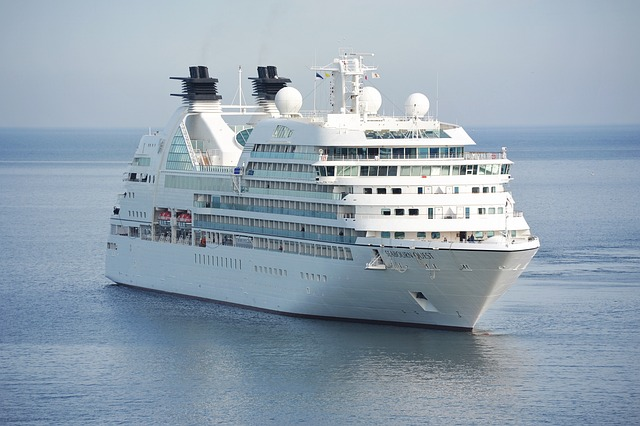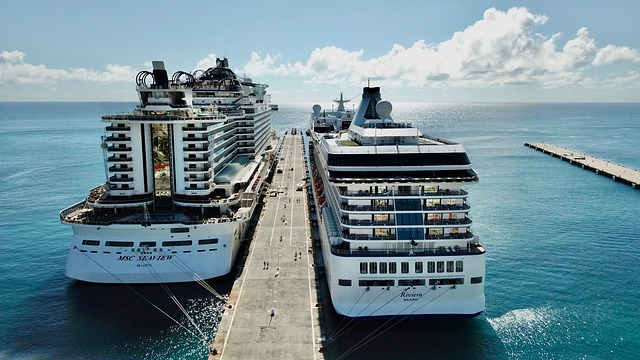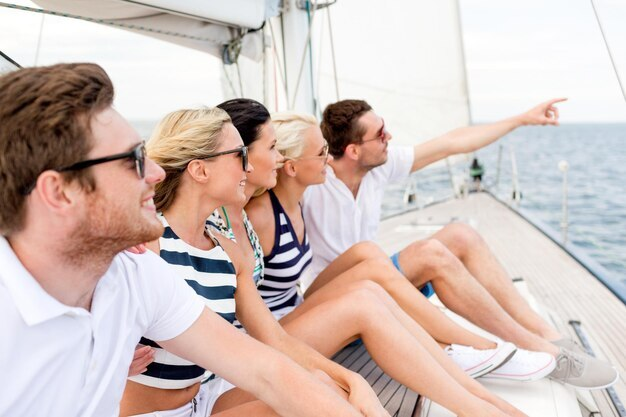Cruise ships have long fascinated people, not just for their luxury and the exotic destinations they sail to, but also for their sheer size. As floating cities equipped with everything from fine dining to swimming pools, the scale of these ships is something to behold. The central question that often comes up is, how many people can fit on a cruise ship? It’s not a simple answer, as it varies from one cruise ship size to another and depends on a myriad of factors.
In this article, we’ll delve into the passenger capacity of various cruise lines, from Royal Caribbean to Norwegian Cruise Line. We’ll also discuss the factors that contribute to a ship’s capacity, such as double occupancy and gross tonnage, to give you a comprehensive understanding of just how many people these modern cruise ships can accommodate.
Understanding Cruise Ship Capacity: The Basics
When it comes to deciphering how many people can fit on a cruise ship, it’s essential to differentiate between two types of capacities: Guest Capacity and Total Capacity. Guest Capacity refers to the number of passengers that can be accommodated in the ship’s cabins. This is typically estimated using a double occupancy model, which assumes two guests sharing each room. On the other hand, Total Capacity includes not just the passengers, but also the crew members who operate the ship.
Calculating these capacities for the largest cruise ships involves several factors, such as the number of cabins and the maximum capacity of public spaces like dining halls and entertainment venues. Gross tonnage, a measure of the ship’s overall internal volume, also plays a role in determining how many people a cruise ship can hold. From Royal Caribbean’s largest ships to Norwegian Cruise Line’s more intimate vessels, these numbers can vary significantly. Understanding these terms can help you get a more complete picture of the cruise line you’re considering for your next voyage.
Factors Affecting Capacity
Navigating the high seas of cruise vacation planning includes understanding ship capacity. In this section, we’ll explore various factors that influence how many passengers a cruise ship can accommodate.
Ship Design
The design of the cruise ship plays a crucial role in determining its passenger capacity. Ships with more decks usually have a higher capacity for guests. For instance, Royal Caribbean’s Icon of the Seas and other large ships in their fleet often have multiple decks dedicated solely to accommodations, increasing the number of people who can sail on the ship.
Room Types
The variety of room types on a cruise ship also influences its passenger capacity. Ships offer an array of rooms from single cabins for solo travelers to double rooms based on double occupancy. Family rooms and suites, which can accommodate more people, also contribute to the overall capacity. Lines like Norwegian Cruise Line and Disney Cruise Line offer flexible room options, increasing the number of passengers they can accommodate.
Amenities and Public Areas
A cruise ship’s amenities and public areas like pools, dining halls, and entertainment venues are also a part of the capacity equation. While these spaces don’t add to the official guest capacity, they do affect the overall experience and comfort level of passengers. Modern amenities can attract more passengers, but they also require space—sometimes reducing the number of cabins and thereby affecting the total capacity. Ships in the cruise industry find a balance by offering attractive amenities without compromising too much on accommodation space.
How Many People Can Fit on a Cruise Ship?
When it comes to passenger capacity, cruise ships can vary greatly depending on their size and design. Generally, they are categorized into small ships, medium, and large ships, each offering a unique experience.
Small Cruise Ships
Small cruise ships are often associated with luxury and intimate settings. One example of a luxury cruise ships that stands out is the Celebrity Xploration, which is currently the world’s smallest cruise ship. This cozy vessel accommodates just 16 guests and offers itineraries focused on exotic destinations like the Galapagos Islands. With a length of just 98.3 feet and a tonnage of 3,195, it offers an ultra-luxury experience at a premium price, starting at approximately $5,799 per person for a week-long journey.
Other examples of smaller vessels include Seabourn’s ships, which can hold about 450 guests, and Viking Cruises, whose ocean-going vessels have a capacity for up to 930 passengers. These smaller ships may not be as affordable as their larger counterparts, but they do offer a more personalized and luxury-focused experience.
Medium-Sized Cruise Ships
When we move into the realm of medium-sized cruise ships, the passenger capacity typically ranges from 2,000 to 4,000 guests. These ships offer a balanced blend of amenities, dining options, and activities without being overwhelmingly large. Norwegian Cruise Line, for instance, has several ships that fit into this category, as do other major players like Disney Cruise Line, Celebrity Cruises, and Carnival Cruises.
These ships usually measure around 1,000 feet in length and provide a range of options that cater to a wider audience. You can find a variety of dining venues, multiple swimming pools, and entertainment options suitable for all age groups. They’re a good choice for those who want a comprehensive cruise experience without the intimidating size of the largest ships in the industry.
Large Cruise Ships
Stepping into the world of large cruise ships, prepare to be awestruck by their sheer size and offerings. At present, Royal Caribbean’s Wonder of the Seas holds the distinction of being the world’s largest cruise ship. Measuring over 1,180 feet in length, this behemoth can accommodate nearly 7,000 passengers at full capacity. Apart from its size, what sets it apart are the eight unique neighborhoods, including a luxurious Suite Neighborhood, making the ship a floating city of sorts.
But it’s not just about size; the ship also offers an extraordinary range of amenities. You can dine in one of its 21 venues or enjoy a drink in one of its 14 bars and lounges. For the adventure seekers, the ship is packed with activities from zip-lining across the ship, multi-story waterslides, Flowrider surfing, ice skating shows to aqua-theater performances. And if you’re planning a Caribbean getaway, you can book a 7-night cruise starting at approximately $1,832 for two people, sailing from Port Canaveral, Florida.
Both medium and large cruise ships offer a wide array of experiences, but the scale of what’s available amplifies as the even larger cruise ships get larger.
World Record Holders: The Biggest Cruise Ships
The cruise industry is a competitive arena where size often matters, and there’s a constant race to build the next biggest thing on water. The current champion is Icon of the Seas, boasting a jaw-dropping gross tonnage of 250,800 GT. This maritime marvel stretches over 1,198 feet and can accommodate 7,600 passengers and 2,350 crew members. Before Icon of the Seas claimed the title, it was Wonder of the Seas and then Symphony of the Seas that wore the crown, each setting remarkable benchmarks in terms of size and amenities.
Symphony of the Seas: An Example
Symphony of the Seas was a pioneer of its time. Launched in June 2017, this Oasis-class vessel has a gross tonnage of 228,081 GT. The ship set a standard for what a high-capacity, floating city could look like, replete with an extraordinary variety of dining venues, entertainment zones, and cutting-edge technology. Though no longer the world’s largest, Symphony of the Seas remains an epitome of luxury and innovation in the cruise industry.
Harmony of the Seas: A Unique Case
Interestingly, when it comes to the length of the ship, Harmony of the Seas takes the cake. Though not the world’s biggest cruise ship in terms of gross tonnage, Harmony has a length of 1,188.1 feet, outstripping its close rival, Wonder of the Seas, by a mere four inches. This makes it an example worth noting, especially for those intrigued by the different dimensions that contribute to a ship’s “size.”
Such record-holding ships symbolize the epitome of luxury, innovation, and engineering marvels in the cruising world. They reflect the industry’s growth and its ever-increasing capability to provide opulent experiences on the high seas.
How Many People Actually Travel on Cruise Ships?
Hey, let’s clear up a common misconception: just because a cruise ship has a “maximum” capacity, doesn’t mean it’s always sailing at full throttle. You know, it’s like when a restaurant has enough tables to serve 100 people, but you rarely see it jam-packed except maybe during the holiday season. Multiple elements come into play when figuring out the precise number of passengers on a cruise ship.
Factors Affecting Actual Numbers
Seasonality: Just like your favorite beach spot, cruise ships have peak and off-peak seasons. You’re more likely to see ships nearing their max capacity during summer breaks or holiday seasons. On the flip side, if you’re looking for a quieter experience, booking during the off-peak months can be a smart move.
Special Events: Think med cruises or cruises tied to specific events like a jazz festival. These cruises may have limited availability because they cater to a particular audience. This can impact the total number of passengers aboard.
Economic Factors: Let’s face it, cruising is a bit of a luxury, and global economic conditions can be a party pooper. The COVID-19 pandemic is a stark example; passenger numbers plummeted in 2021 to below five million but started recovering in 2022 to just above 20 million. It shows how external events can dramatically affect how many people actually set sail.
The Average Scenario
To give you a ballpark idea, medium-sized cruise ships usually have the capacity to hold about 3,000 guests. Major players in the cruise industry typically operate ships that can accommodate between 2,000 to 4,000 guests. But remember, these numbers are more like speed limits rather than the actual speed of the car if you catch my drift.
So, there you go! The next time someone quotes the “maximum capacity” of a cruise ship, you’ll know that the real story is a bit more nuanced.
Importance of Crew Passenger Ratio
Let’s talk numbers, but not the ones you might expect. When it comes to cruising, there’s a little-known ratio that can make or break your experience—the crew-to-passenger ratio. It’s not as flashy as the number of pools or dining options, but trust me, it can be a game-changer.
The golden standard? A 1:1 ratio, or even better. Imagine going to a café where there’s a barista for every customer. Your coffee would be perfect, right? In the same vein, a 1:1 ratio on a cruise ship means exceptional, personalized service. The fewer passengers each crew member is responsible for, the more time and attention you’re likely to receive. In essence, a favorable ratio is a good indicator that you won’t be waving down a waiter for ten minutes to get another piña colada.
A good crew-to-passenger ratio ensures that the onboard staff can promptly and adequately respond to your needs, from the concierge helping with shore excursions to room service delivering that midnight snack you suddenly crave. It can make a world of difference in your overall experience, transforming a good vacation into an unforgettable one.
If you’re eyeing a luxury cruise experience, you’ll often find the ratio tends to skew closer to 1:1. That’s one of the reasons why these cruises are pricier—it’s like opting for the VIP experience at a concert. On larger ships with higher capacities, the ratio might not be as favorable, which could mean less personalized service. But hey, some people are fine with that, especially if they’re more about the activities and amenities than one-on-one service.
So next time you’re diving into cruise brochures or scrolling through websites, don’t just gloss over the crew-to-passenger ratio. It’s a small detail that can set the stage for the entire vibe of your voyage.
What Is the Maximum Size of Cruise Ships?
Ever looked at a massive cruise ship and wondered, “Just how big can these floating cities get?” Well, there’s no simple answer. The maximum size of a cruise ship isn’t just determined by how much steel and innovation you can throw at it. There are several regulations and safety protocols in place that dictate the upper limits of a cruise ship’s size.
Safety Regulations and Protocols
When it comes to cruise ships, bigger isn’t always better, especially if it compromises safety. Various maritime regulations outline the safety features a ship must have, like lifeboats, fire suppression systems, and the maneuverability to evacuate passengers safely. These rules implicitly limit how large a cruise ship can be. For example, the vessel is required to have a sufficient number of lifeboats to hold all passengers and crew members onboard. Similarly, the navigational systems must be sophisticated enough to handle the ship’s sheer size and weight, especially in emergency situations.
Conclusion
In summary, the world of cruise ships is a fascinating blend of luxury, innovation, and strict regulations—all aimed at giving you a vacation you won’t forget. While the size and capacities of these ships can be awe-inspiring, they are carefully calibrated factors, shaped by design considerations, safety protocols, and even global events like the COVID-19 pandemic.
Going forward, the industry is in a constant state of evolution, placing an increased emphasis on health and safety. Whether you’re boarding a boutique ship with just a handful of cabins or stepping onto a floating city with thousands of fellow explorers, it’s essential to understand these dynamics. So the next time you’re sipping a cocktail on the deck, you’ll appreciate the intricate world that keeps these nautical marvels afloat.
FAQs
How many people fit on the largest cruise ship?
The world’s largest cruise ship, Icon of the Seas, has a staggering capacity to carry 7,600 passengers along with 2,350 crew members. It’s a floating city with amenities to match, offering an expansive travel experience like no other.
Can a 5 person family go on a cruise?
Absolutely, a 5-person family can enjoy a cruise vacation together. Many ships offer family-friendly rooms and suites designed to accommodate larger groups. Moreover, cruise operators frequently offer activities and facilities geared toward families to ensure that everyone stays engaged.
What is the average capacity of a cruise ship?
The average cruise ship has a passenger capacity of about 3,000 guests. This can vary significantly depending on the size and type of the ship, ranging from small luxury vessels with fewer than 500 passengers to enormous liners that can accommodate over 6,000 people.







